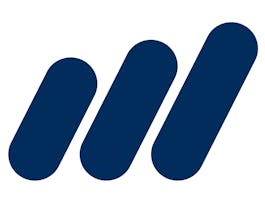In this Capstone you will recommend a business strategy based on a data model you’ve constructed. Using a data set designed by Wharton Research Data Services (WRDS), you will implement quantitative models in spreadsheets to identify the best opportunities for success and minimizing risk. Using your newly acquired decision-making skills, you will structure a decision and present this course of action in a professional quality PowerPoint presentation which includes both data and data analysis from your quantitative models.



Wharton Business and Financial Modeling Capstone
This course is part of Business and Financial Modeling Specialization



Instructors: Richard Lambert
Sponsored by Barbados NTI
11,046 already enrolled
(491 reviews)
Skills you'll gain
Details to know

Add to your LinkedIn profile
6 assignments
See how employees at top companies are mastering in-demand skills

Build your subject-matter expertise
- Learn new concepts from industry experts
- Gain a foundational understanding of a subject or tool
- Develop job-relevant skills with hands-on projects
- Earn a shareable career certificate


Earn a career certificate
Add this credential to your LinkedIn profile, resume, or CV
Share it on social media and in your performance review

There are 5 modules in this course
Welcome! This opening module was designed to give you an overview of the Business and Financial Modeling Capstone, in which you will be working with historical financial data to calculate individual returns and summary statistics on those returns. The project has multiple steps, which are outlined below in the "Project Prompt", and culminates in a recommendation for portfolio allocation that you will prepare a presentation on. You will draw on elements from all courses to complete this project, and you can use your final presentation as a work sample to improve your current job or even find a new one. Before moving on, complete the "Project Scope Quiz." The work you do this week enables you to understand the steps needed to successfully complete your final project.
What's included
3 readings1 assignment2 discussion prompts
In this module, which correlates to Steps 1 and 2 in the Project Prompt, you'll be working with a historical data set to calculate performance data and to provide summary statistics on that data. These calculations will allow you to practice using Spreadsheets for financial calculations, and provides the foundational skills and numbers for the next steps of the project. First, you'll use the set to calculate daily returns on a set of securities. You'll then use your Spreadsheet skills to calculate summary statistics. You'll be given the opportunity to test your knowledge with a sample return to see if your calculations are correct. And you may want to refresh your recollection of the content from the Specialization with the lectures included here. The work you complete this week allows you to form the basis for comparing stock performance, which you will use in creating the investment portfolio for your final project as well as the comparison to the performance of a single stock.
What's included
6 videos4 readings2 assignments1 discussion prompt
In this module, you'll go beyond calculating simple returns to tackle the more advanced task of finding the minimum variance and "optimal risk portfolio" weights for a portfolio of selected securities (note, the "optimal risky portfolio" is also known as an "optimal portfolio" or "tangent portfolio"). You'll follow the tasks in Step 3 in the Project Prompt and use the resources below to calculate the portfolio weights for two securities that results in the portfolio with the minimum variance; then, you'll calculate the "optimal risky portfolio" on the efficient frontier for these same two securities, then for all 10 stocks in the pool. You'll be quizzed on your calculations and other insights that emerge from this exercise. The work you complete this week gives you practice in creating an optimal risky portfolio, which is a key component of your final project. Note: There are a number of resources available on the internet providing step-by-step instructions on how to use Excel to create an "optimal risky portfolio" on the efficient frontier given a certain set of available assets. We encourage you to attempt to use the skills you gained during the Specialization to work through these steps independently; you are, however, permitted to utilize third-party resources if you find it necessary. We've included some lectures from the underlying Specialization courses concerning Solver, optimization, and other relevant topics.
What's included
7 videos5 readings1 assignment2 discussion prompts
The Capital Asset Pricing Model, or CAPM, is another tool used by investors to weigh the risks and rewards of potential investments. In this optional module covering Step 4 in the Project Prompt, you can use CAPM as a vehicle to further strengthen your financial modeling skills, including using regression concepts. You may revisit the Specialization lectures below touching on regression. To test whether you've grasped the concepts in the CAPM model, this module includes a short quiz. This assessment is formative, meaning your score will not count towards your final grade. The work you do this week may inform how you build the mixed asset portfolio of your final project, but it is not necessary to complete the final project.
What's included
3 videos3 readings1 assignment1 discussion prompt
In this final module you are asked to move beyond a stock-only portfolio to one utilizing more diversified assets and to prepare a short presentation summarizing your findings. As explained in Step 5 of the Project Prompt, you have $5 million to invest in the Vanguard Total Bond Market Index Fund (ticker: VBTLX) and Vanguard 500 Index (ticker: VFIAX) investment vehicles. There are two assessments in this module. First, you'll complete a short quiz on the characteristics of your optimal risky portfolio. Then, in the peer review component of this Capstone, you are tasked with preparing a short presentation that (i) explores how your portfolio of mixed asset class of funds compares to a single security (AAPL) and (ii) uses that comparison to discuss the importance of portfolio diversification.
What's included
1 reading1 assignment1 peer review3 discussion prompts
Instructors


Offered by
Why people choose Coursera for their career




Learner reviews
491 reviews
- 5 stars
76.42%
- 4 stars
12.19%
- 3 stars
5.69%
- 2 stars
1.82%
- 1 star
3.86%
Showing 3 of 491
Reviewed on Jul 28, 2020
Good capstone, online learning in general is a bit frustrating, but the course was solid and I appreciated the chance to do something more interactive. Recommended!
Reviewed on Sep 8, 2024
The course was very informative The capstone project could have had more explanatory videos for better understanding of the questions provided in the quizzes and peer graded assignment.
Reviewed on Apr 8, 2021
It is a well drafted course that helps in enhancing the knowledge of financial modeling and also prepare in tackling important financial decisions.
Recommended if you're interested in Business

Emory University

Corporate Finance Institute

The University of Melbourne

Open new doors with Coursera Plus
Unlimited access to 10,000+ world-class courses, hands-on projects, and job-ready certificate programs - all included in your subscription
Advance your career with an online degree
Earn a degree from world-class universities - 100% online
Join over 3,400 global companies that choose Coursera for Business
Upskill your employees to excel in the digital economy



